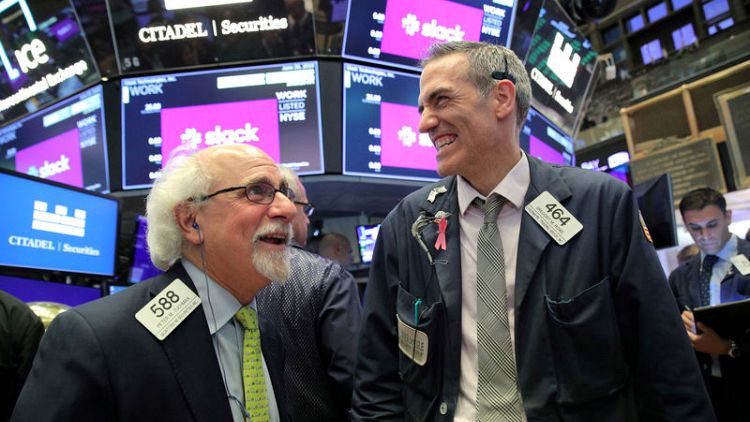LONDON (Reuters) - AFTER THE HALF-TIME WHISTLE
After a remarkable six months, it might be too much to hope that scintillating returns earned by almost every sector - whether stocks or bonds, emerging markets or gold - can be replicated in the second half of the year. It's been a barbell approach - dash for safety alongside a reach for yield. But what drives markets from here? Will gloom about economic growth and trade push more investors into bonds and gold? Or will monetary easing promises in the United States, Europe, Japan and China boost riskier markets? Conceivably, growth won't be as dire as the outlook suggests, allowing central banks to hold fire.
The world economy will turn on how the Sino-U.S. trade talks end, and whether U.S.-Iran tensions turn into something worse. But wait, isn't there the Powell Put? The ECB, Bank of Japan and People's Bank of China also stand ready to turn on the stimulus taps if things turn ugly. In fact, while markets will be happy to see growth recover, they seem to prefer wallowing in central bank largesse. And with that comfort blanket wrapped around markets, the second half of 2019 probably won't be too bad.
-Masters of what universe? Central bankers in a bind as G20 bickers over trade
-G20 heads struggle to narrow differences beyond their concern on global growth
-The best first-half ever for world markets?
(Graphic: Global markets asset performance H1 2019 link: https://tmsnrt.rs/2FEcGYS)
WILL THERE BE WHITE SMOKE?
EU leaders head for Brussels on Sunday to try and parcel out the bloc's top jobs. The appointees will lead the bloc's policies for the next five years on issues ranging from monetary policy to migration and Brexit to trade.
The wrangling was compared by one leader, Ireland's Leo Varadkar, to electing a pope. But while a recent meeting failed to yield agreement, there is a good chance the upcoming summit will tell us the name of the next European Commission president. Berlin and Paris have been at loggerheads over who should take the helm of the Commission -- German Manfred Weber or French President Emmanuel Macron's pick Michel Barnier. So the smart money is on a compromise candidate, possibly Denmark's Margrethe Vestager.
The big reveal for the European Central Bank presidency is likely to come at a later date but the nationality of the new Commission head will offer big clues at least on where the next ECB boss will come from. A German at the helm of the Commission should mean Bundesbank head Jens Weidmann, a known hawk feared by market participants, will not get the ECB role. Likewise a commission presidency for France would rule out French ECB candidate Francois Villeroy de Galhau. So Finland's Ollie Rehn stands out as the likely compromise.
-Merkel cautions EU leaders over choice of EU Commission chief
-Divided EU leaders set sorting out euro zone budget financing as priority
-EU aims to complete top jobs jigsaw puzzle on June 30
(Graphic: EU top jobs IMG link: https://tmsnrt.rs/2WTUzIp)
SUMMER JOBS
The U.S. June jobs report will be released between the July 4 holiday and the weekend when many market players are absent. But even if trading volumes are lower than usual, the data won't be getting short shrift from anyone.
Whether the Federal Reserve cuts interest rates at its end-July meeting by half a percent, a quarter, or not at all, hinges partly on whether job creation stays as sluggish as May, when payrolls rose 75,000 -- 110,000 below forecasts.
That was the second time this year monthly jobs growth dropped below 100,000 -- the level needed to keep up with the rise in the working-age population. Along with tepid wage growth, a weak figure will heap more pressure on policymakers to move into easing mode.
The economy is expected to have created 165,000 nonfarm jobs in June while interest rate futures indicate 100% odds of a 25 basis-point cut on July 31 and a 26% chance of a 50-basis-point reduction. But traders might be getting ahead of themselves. Fed Chairman Jerome Powell has pushed back on rate-cut pressure. And the economy looks generally robust - unemployment, at 3.6%, is at its lowest in half a century and it likely stayed there in June.
-Weak U.S. employment report raises red flag on economy
-Fed pushes back on aggressive U.S. rate cut views
-U.S. labour market on solid ground; manufacturing struggling
(Graphic: US non-farm payrolls link: https://tmsnrt.rs/2YgRy2p)
THE CRUDE TRUTH ON OPEC
Decision-making has never been easy for the Organization of the Petroleum Exporting Countries - a group of 14 Arab and non-Arab oil producers, many of which harbour longstanding rivalries. But even by OPEC standards, things have become tetchier of late.
A month-long wrangle to set a meeting date highlighted the changing dynamic within the group, with decisions increasingly taken by long-time leader Saudi Arabia together with non-OPEC Russia -- much to the chagrin of members like Iran.
OPEC power brokers will gather in Vienna on Monday and meet with non-OPEC states - known as OPEC+ - on Tuesday. They need to decide whether to extend a deal on oil output curbs that expires end-June.
How much impact any decision will have is a question in itself. Oil output in Iran and Venezuela, both under U.S. sanctions, has fallen by more than that of fellow OPEC states that are actually meant to be party to the supply cut pact. So actual supply is down by 2.5 million barrels per day (bpd) versus the 1.2 million bpd that was agreed. Evidently, President Trump has had more impact on oil production than OPEC.
-Trump's sanctions cut more OPEC oil output than OPEC itself
-Hedge funds pause oil sales as Mideast tensions rise: Kemp
-OPEC set for rollover, may discuss deeper oil curbs - Iraq
(Graphic: World crude oil production and demand by region png link: https://tmsnrt.rs/2ZFAZ0e)
BACK TO BITCOIN
Is Bitcoin back? With an over 200% gain already this year, it sure looks like it. The recent surge is partly down to investors looking to diversify portfolios as bond yields fall ever lower. But for the most part, buyers are being driven by speculation that Bitcoin and its peers will rise in value if Facebook's crypto offering Libra becomes a hit. But the key word is "if'.
Facebook plans to launch its digital coin in the first half of 2020 but regulators' reaction has mostly been one of scepticism. The financial services committee in the U.S. Congress has told Facebook to stop development of the project until big questions are answered, while Germany's anti-trust watchdog said it could scrutinise coins from internet giants. And so on.
Those and other comments deflated the rally somewhat, pushing Bitcoin down more than 20% in two days. It will probably keep it well off the $20,000 record high hit in December 2017. But further weakness in mainstream currencies, should central banks resume policy easing, might well benefit Bitcoin.
-Bitcoin slides 12%, ending recent surge
-Bitcoin soars past $13,000 as Facebook's Libra fuels demand
-European watchdogs demand detail on Facebook's cryptocurrency
(Graphic: Bitcoin's back link: https://tmsnrt.rs/2YjQR8i).
(Reporting by Sujata Rao, Virginia Furness, Karin Strohecker and Olga Cotaga in London; Alden Bentley in New York; editing by John Stonestreet)



